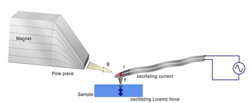Home > Press > Anasys report on the Lorentz Contact Resonance imaging mode now available for their afm+ and nanoIR systems
 |
| Schematic to illustrate Lorentz Contact Resonance imaging |
Abstract:
Anasys Instruments continues to expand the capabilities of their nanoscale materials characterization techniques with the Lorentz Contact Resonance (LCR) imaging mode. This is now available for their afm+® and nanoIR™ systems.
Anasys report on the Lorentz Contact Resonance imaging mode now available for their afm+ and nanoIR systems
Santa Barbara, CA | Posted on March 26th, 2013The Lorentz Contact Resonance imaging mode further enhances the capabilities of the afm+ and nanoIR systems from Anasys. LCR allows rapid broadband nanomechanical measurements over a range of temperatures. LCR imaging differentiates between multiple components of a sample and allows precise location of the probe for subsequent chemical or thermal analysis with nanoscale resolution.
LCR provides both nanomechanical spectroscopy and compositional mapping on the highest levels of resolution. For example, analysis of wideband contact resonance spectra may readily differentiate different domains in polymer blends while the high resolution image maps provide insight to materials components in heterogeneous polymer blends.
The technique is based upon the Anasys proprietary Thermalever™ probes. LCR works by using a pole piece to focus a magnetic field onto the end of the probe. An oscillating current is then passed through the probe. The interaction between the magnetic field and the electric field causes a perpendicular force in the cantilever resulting in an oscillating behavior of the cantilever. Driving the tip in this fashion, instead of with a piezoelectric crystal, provides many advantages, including no moving parts in the drive system leading to clean cantilever resonance spectra with no parasitic peaks. Then, using the Anasys Analysis Studio software, a wide range of frequency sweeps are made (from 1 kHz to 4 MHz). By placing the Thermalever probe on the surface of a sample and sweeping the entire frequency range, we can obtain mechanical spectra of the surface. Materials with different stiffness will display different amplitudes or shifted peaks at the resonant frequencies of the cantilever.
This work has been recently published in the journal, Nanotechnology. The reference is Lee, B.; Prater, C. B.; King, W. P. Nanotechnology 2012, 23, 055709.
####
About Anasys Instruments
Anasys Instruments is dedicated to delivering innovative products that measure material properties for samples with spatially varying physical and chemical properties at the nanoscale. Anasys introduced the nano-TA in 2006 which pioneered the field of nanoscale thermal property measurement. In 2010, Anasys introduced the award-winning breakthrough nanoIR™ Platform which pioneered the field of nanoscale IR measurement. Most recently, Anasys is proud to introduce the breakthrough Lorentz Force Contact Resonance, which pioneers the field of wideband nanomechanical spectroscopy.
For more information, please click here
Contacts:
Anasys contact:
Roshan Shetty
Anasys Instruments Corporation
121 Gray Avenue, Suite 100
Santa Barbara
CA 93101 USA
Tel: +1 (805) 730-3310
www.anasysinstruments.com
Media contact:
Jezz Leckenby
Talking Science Limited
39 de Bohun Court
Saffron Walden
Essex CB10 2BA, UK
Tel +44 (0) 1799 521881
Mob +44 (0) 7843 012997
www.talking-science.com
Copyright © Anasys Instruments
If you have a comment, please Contact us.Issuers of news releases, not 7th Wave, Inc. or Nanotechnology Now, are solely responsible for the accuracy of the content.
| Related News Press |
News and information
![]() Simulating magnetization in a Heisenberg quantum spin chain April 5th, 2024
Simulating magnetization in a Heisenberg quantum spin chain April 5th, 2024
![]() NRL charters Navy’s quantum inertial navigation path to reduce drift April 5th, 2024
NRL charters Navy’s quantum inertial navigation path to reduce drift April 5th, 2024
![]() Discovery points path to flash-like memory for storing qubits: Rice find could hasten development of nonvolatile quantum memory April 5th, 2024
Discovery points path to flash-like memory for storing qubits: Rice find could hasten development of nonvolatile quantum memory April 5th, 2024
Imaging
![]() Nanoscale CL thermometry with lanthanide-doped heavy-metal oxide in TEM March 8th, 2024
Nanoscale CL thermometry with lanthanide-doped heavy-metal oxide in TEM March 8th, 2024
![]() The USTC realizes In situ electron paramagnetic resonance spectroscopy using single nanodiamond sensors November 3rd, 2023
The USTC realizes In situ electron paramagnetic resonance spectroscopy using single nanodiamond sensors November 3rd, 2023
![]() Observation of left and right at nanoscale with optical force October 6th, 2023
Observation of left and right at nanoscale with optical force October 6th, 2023
Announcements
![]() NRL charters Navy’s quantum inertial navigation path to reduce drift April 5th, 2024
NRL charters Navy’s quantum inertial navigation path to reduce drift April 5th, 2024
![]() Discovery points path to flash-like memory for storing qubits: Rice find could hasten development of nonvolatile quantum memory April 5th, 2024
Discovery points path to flash-like memory for storing qubits: Rice find could hasten development of nonvolatile quantum memory April 5th, 2024
Tools
![]() Ferroelectrically modulate the Fermi level of graphene oxide to enhance SERS response November 3rd, 2023
Ferroelectrically modulate the Fermi level of graphene oxide to enhance SERS response November 3rd, 2023
![]() The USTC realizes In situ electron paramagnetic resonance spectroscopy using single nanodiamond sensors November 3rd, 2023
The USTC realizes In situ electron paramagnetic resonance spectroscopy using single nanodiamond sensors November 3rd, 2023
|
|
||
|
|
||
| The latest news from around the world, FREE | ||
|
|
||
|
|
||
| Premium Products | ||
|
|
||
|
Only the news you want to read!
Learn More |
||
|
|
||
|
Full-service, expert consulting
Learn More |
||
|
|
||








